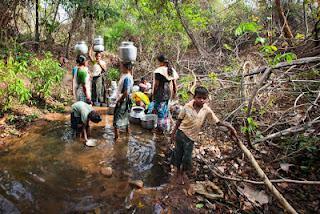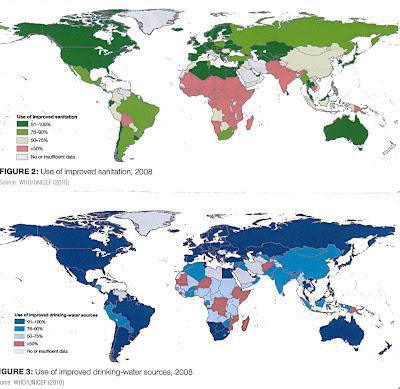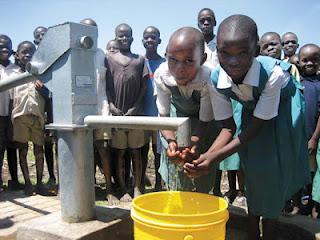
Gathering unsafe water in India
I’m fond of saying that the modern world started when indoor plumbing,fresh water and modern sanitation, became widely available. Not only did these innovations make conditions far more sanitary but it also promoted better hygiene [1]. For the United States, this happened inthe later nineteenth and early twentieth centuries [2], and by the decade afterWorld War II most urban and rural areas of westernized nations had modernplumbing; clean water was delivered to the house and dirty water carried away.This development had a profound effect on public health. Cholera,dysentery, and typhoid fever were among the common epidemics suffered inLondon, New York, and other major western cities before what I’ll term the safewater infrastructure was in place. Now those diseases are largely unknown inthe west. I’m guessing that for most readers of this blog, safe water is takenlargely for granted, as it was by our parents and even our grandparents. Infact, a resident of New York or London probably thinks that the word cholera isquaint and foreign, when as little as 100 years ago it would have caused mortaldread.
Unsafe Water
This isn’t the case everywhere though. Cholera still afflicts millionsof people worldwide each year, and a major outbreak occurred in Haiti after themassive, crippling 2010 earthquake. This is because even now, in 2012, billions ofpeople across the globe still lack access to clean drinking water and modernsanitation. Here are a few eye-opening statistics from the World HealthOrganization (WHO):
- 900 million people lack access to drinking-water from improved watersources (13% of the world population);
- 2.6 billion people lack access to improvedsanitation facilities (37% of the world population);
- 2.2 million children die worldwide each year from unsafewater.
- Unsafe water is a major risk factor for diarrheal disease, which is thesecond leading contributor to the global disease burden.
Here are a couple of maps, taken directly from the U.N.’s 2010 Global Annual Assessment of Sanitation and Drinking-Water (GLAAS) report thatillustrate the current safe water crisis (click on them to enlarge):

The top map shows the state of improved sanitation. The pink coloredcountries are where less than 50% of the population has access to improvedsanitation; the light green colored countries are where less than 75% of thepopulation has access to improved sanitation. The first category includes thegreat majority of sub-Saharan Africa as well as south Asia. The second categoryincludes China, the world’s most populous nation. Less than 90% of thepopulations of Brazil, Russia, Argentina, and Mexico have access to improvedsanitation.
The bottom map shows the state of improved drinking water. The pink coloredcountries are where less than 50% of the population has access to improveddrinking-water; the light blue colored countries are where less than 75% haveaccess; and the medium blue colored countries are where less than 90% haveaccess. The first and second categories include the great majority ofsub-Saharan Africa. The third category includes India and China, the world’s twomost populous nations. Not surprisingly, all of these nations, including Indiaand China, fare very poorly in the U.N.’s Human Development Index, whichattempts to quantify overall quality of life by country [3]. This is hardly surprising;it’s difficult to imagine human development being high where safe water is a luxury.
Only the most oblivious of westerners is unaware of the deep povertythat grips much of the world, including huge portions of Asia and Africa. Still,providing clean water and sanitation to the population should be a primary goalfor all developing countries. The public health and general benefits of safewater are obvious, and have been obvious for generations. The WHO estimatesthat for every $1 invested in safe water, $3 to $34 in economic benefits arerealized. Lower health care costs, fewer sick days, less time spent in searchof clean water, and deaths averted, are only the most directly related outcomes.China is widely viewed as a new global power with the world’s second largesteconomy. India is viewed as a future power. Together they are home to more than35% of the world’s population. Yet both have failed to provide universal accessto safe water [4].
Slow Progress
A read of the 2010 GLAAS report provides a sobering overview of thecurrent situation. The reasons why billions continue to lack safe water rangefrom low prioritization and low investment in developing countries; to foreign aidthat is poorly managed on a national level and inefficiently targeted to areasmost in need; and various international, national, and sub-nationalbureaucracies working at cross purposes. International aid for safe water lagsfar behind spending on education and other health initiatives like HIV/AIDS preventionand treatment. The percentage of international aid dedicated to safe water hasactually declined over the last 15 year from 8% in 1997 to just 5% today. Italso appears that developing nations are spending only a tiny fraction of theirGDP on safe water projects. Still, at least in rural areas there has beenimprovement since 1990, with 10% less of the global rural population exposed to unsafe water than was true two decades ago. Nevertheless, progress hasbeen achingly slow.
What is frustrating to an outside observer is the fact that providing safewater to the vast majority of the world’s people, both urban and rural is anachievable goal. In some places, like the deserts and highly arid areas ofAfrica, true water scarcity is an issue, but in most locations adequate watersources exist. Clean water technology is straightforward even if it does require a lotof infrastructure [5]. But consider the chaotic mix of fundingfrom dozens of international donor organizations, a developing nation’s (likelyvery strained) internal budget, competing national policies and politics, variousnational and regional improvement plans, the availability of national and localresources, chronic and acute national and local crises, shifting nationalpriorities, the varying quality and stability of political leadership, thelevel of technical expertise, and the size and sophistication of the privatesector. Out of all of that there needs to develop a coherent plan to providesafe water where it’s needed. No wonder progress has been slow and billions arelikely to remain without safe water for decades to come.

A clean water pump in rural Africa
If annual international investment for safe water were to double fromthe current $7.5 billion to $15 billion, there is no doubt that huge gains could be made(assuming of course that the increased funding was appropriately targeted andmanaged). This figure is by no means a meager sum, but surely something thewestern world could support. For comparison, U.S. government non-military foreign aid in 2010 was $38 billion, and private donations to developingcountries from the U.S. amounted to another estimated $12 billion. That’s $50billion annually from one country. There’s enough money out there to provide safewater everywhere. And that doesn’t even consider the extra money that would be availableif developing nations made providing universal safe water the priority itshould be. The GLAAS report includes many recommendations to try and pull allof the disparate funding sources and various national policies into amanageable plan. Hopefully those recommendations will lead to better action.I’m not optimistic that safe water will become universally available inthe near term, but maybe the right leaders and the right policies will emergeto make unsafe water a piece of history for the developing world like it’s beenfor generations in the west. Think of the global benefit, both economically andin the broader quality of life measures that would comefrom providing everyone with safe water. I hope I live to see it.
---
NOTES:
[1]Cleanliness may be next to godliness, and it’s certainly related to betterhealth. And let’s not overlook its role in more…um, pleasant…socialinteractions.
[2]For example, I live less than a mile from Loch Raven reservoir just a few milesnorth of Baltimore. I run through the woods and along the shores of thereservoir several times each week. It's a very beautiful sylvan setting, but ithas an important purpose. The reservoir was formed about a century ago when theBig Gunpowder Falls River was dammed to provide a largereliable source of drinking water for the city. The reservoir feeds anunderground aqueduct that transports water seven miles to Lake Montebello inthe middle of Baltimore. There the water is treated and pumped out to the cityand most of Baltimore County, including my house, for consumption. Used water then flows from myhouse through sewers to the Back River waste water treatment plant just east of Baltimore.Once treated the water is clean and is released into Back River. This is acommon urban approach to water delivery and treatment. Rural houses often gettheir water from wells and the waste water flows into an underground septictank.
[3]The definition of human development provided in the 2010 report is: “Humandevelopment is the expansion of people’s freedoms to live long, healthy andcreative lives; to advance other goals they have reason to value; and to engageactively in shaping development equitably and sustainably on a shared planet.People are both the beneficiaries and the drivers of human development, asindividuals and in groups.”
[4]All four “BRIC” nations, the others being Brazil and Russia, also struggle toprovide safe water for all of their citizens.
[5]For urban areas: a water source, treatment facilities, pumps and pipes todistribute clean water and collect waste water, and sophisticated waste watertreatment facilities to ensure that the dirty water doesn’t pollute the watersupply. For rural areas: a water source, which could be as simple as a localwell, and sanitation facilities that collect waste water and ensure it does notcontaminate the groundwater or other clean water source. In some places it mayrequire long aqueducts to transport water to an urban area, but these have beensuccessfully built – at a high cost – for both New York and Los Angeles.

